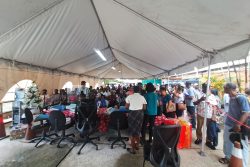Dear Editor,
While not attempting to join the healthy verbal exchange between a senior member of the government and a senior aviator on the suitability of the Bell 206 helicopters just bought by the administration, I wish to point out the principal strengths and weaknesses of the decision as a learning point as we move forward.
What we must accept is that the deal is done and Guyana must utilise these bits of equipment to the best of its ability notwithstanding that these helicopters have limitations.
Strengths of the Bell 206
1. It has a maximum cruise speed of just over 200 km/h and thus can reach Rose Hall in just under an hour, which is a vast improvement from our immediate past capability.
2. This equipment has now empowered the Joint Services to react more swiftly with its first insertion into a crime zone until the back up arrives.
3. It flies at a maximum distance of just over 600 km which would allow it to access even a border town like Lethem without refuelling.
4. It is a very reliable machine that is accustomed to tough conditions.
5. It has a very good safety record.
6. It has a low operating and maintenance cost compared to other helicopters in this class which is a tremendous strength considering government’s history with maintenance of equipment.
7. The Charlotte, Chicago and Dallas Police Depart-ments did use a Bell 206 in their Aviation Unit for urban surveillance and crime fighting but they were a minority rather than the flagship since they found the Bell 407 to be a more capable machine.
8. The presence of a helicopter overhead helps tremendously to pin down criminals.
9. The psychological effect of a helicopter overhead reduces the chances of a suspect overcoming forces on the ground.
10. Any helicopter can increase an officer’s safety on the ground immensely especially if it is equipped with a remote control machine gun under the control of the pilot and this can be attached to the Bell 206.
Weaknesses of the Bell 206
1. Better suited for fire fighting, mosquito control, news gathering, support to the offshore oil industry, aerial application in the agricultural sector and air tourism but certainly not heavy duty crime fighting.
As a strength out of this weakness, the Ministry of Health can use them in their mosquito control programme, we can sell them to CGX in the future when they ramp up their operations, Guysuco or large rice farmers can rent them for large scale chemical application and the tourism sector can make good use of these helicopters.
2. It seats about five persons including the pilot and thus can only ferry four crime fighters (or in the case of two helicopters – eight) to engage a small criminal battalion of 10-20 heavily armed criminals in a remote town like Rose Hall.
This puts the crime fighters at a disadvantage but if they are eight highly trained men joining the local policemen they can make a difference.
In the case of Lusignan, if eight men in two helicopters were air dashed to the backlands to join the policemen from Vigilance and BV who would have covered the front lands, they may have made a difference until the rest of the TSU squad arrived from Georgetown to close the show.
3. Single-engine, meaning that it is best for use over the coastlands rather than over the jungles.
In case of an engine failure, which should be remote considering the reliability of the equipment, it is better to be over the coast with more option to land rather than over the jungle.
4. The Charlotte Police Department replaced the Bell 206 with a Bell 407 because it had inadequate crime-fighting features and capabilities to meet its needs.
5. These helicopters are second hand (in one case over 10,000 flying hours were chalked up).
Recognising that the deal is done, I would suggest that we should be grateful that we now have two functioning helicopters. The administration was in a difficult position in February since it was under severe pressure to do something and do it fast. It has now done something and we all have to support the effort now to minimise crime in Guyana.
What to do?
We should put these helicopters to work immediately, while at the same time upgrading them with search lights, machine guns etc. and get on with fighting crime. As a back-up plan, we should refurbish the Bell 412 immediately since it is still a more dependable machine than these Bell 206.
In retrospect, a better piece of equipment to buy could have been the Bell 212 helicopter, which has a twin engine and is built for tactical operations. It cost brand new, approximately US$5 million fully loaded with three sets of guns and search capabilities all under the control of the two pilots and could have been bought second hand, for less. But let us leave this for next year’s budget which should give the government enough time to consult widely on the next purchase which must be made because these Bell 206 helicopters will help only do so much. Hopefully, the next time we buy helicopters we will do it better and smarter and get real value for money.
Yours faithfully,
Sasenarine Singh
UK





